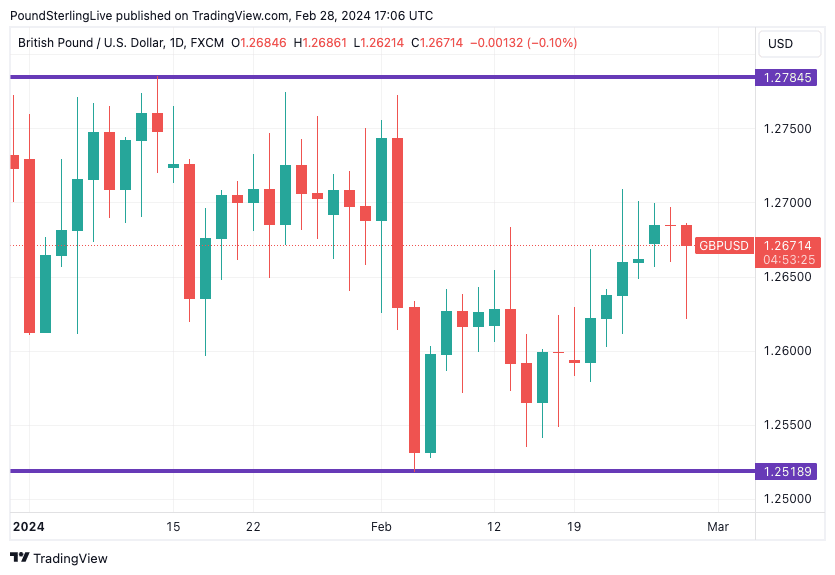Pound Sterling Volatility Near 30-year Low
- Written by: Gary Howes

Image © Adobe Images
This is an incredibly becalmed FX market, and the Pound, a once go-to for volatility, is proving particularly steady.
"Implied volatility is particularly low in GBP, at close to the lowest in the past thirty years," says Joseph Capurso, Head of International and Sustainable Economics at Commonwealth Bank.
The Pound Sterling has held a reputation for political-linked volatility since the run-up to the 2016 Brexit referendum, but a significant improvement in domestic politics and faded Brexit risks have erased any jitters from the currency.
At the same time, a relatively sanguine economic outlook, belied by the flat economy and steady communications from the Bank of England regarding interest rate policy, also contribute to the low-volatility environment.
Above: GBP/USD implied volatility, one month at the money. Image: CBA.
The British Pound is walking a well-trodden path against the Euro and Dollar, with current Pound-Euro and Pound-Dollar exchange rates seemingly unwilling to budge.
GBP/USD has traded a 250 pip range in 2024, which is incredibly tight by historical standards, despite the ongoing speculation regarding Federal Reserve rate cut timing.
EUR/GBP rate has held a similar sized range, but this has tightened to a historically unusual 100-pip range since mid-January. "EURGBP has seen a modest bounce from its 0.85 lows, but remains in its well-established trading range. We expect this rangebound trading for the pairing to last given the similarities of the two underlying economies," says Patrick Ernst, an analyst at UBS.
Compare Currency Exchange Rates
Find out how much you could save on your international transfer
Estimated saving compared to high street banks:
£25.00
Free • No obligation • Takes 2 minutes
The low volatility environment is a feature of the broader market, too, according to Capurso:
"G10 FX realised and implied volatility has fallen appreciably in the past six months. FOMC chair Powell’s dovish pivot in late 2023 helped pull volatility down because it encouraged market participants to price in a soft landing in the US and elsewhere."
"A soft landing undermines volatility because it improves certainty of the future economic outlook," he adds.
"The FX market is bottled up and waiting for some monetary policy divergence, which simply isn’t forthcoming," says Kit Juckes, head of foreign exchange research at Société Génerale
Above: GBP/USD's range in 2024 has been tight compared to historical norms over a similar period. Track GBP with your own custom rate alerts. Set Up Here
Regarding the Pound's low volatility, Capurso says the very low implied volatility in GBP "is all the more remarkable given the UK’s poor economic performance and the uncertainty of the impact of Brexit on the UK."
But we would differ on this point as the soft landing narrative is also relevant to the UK, which has avoided the multi-month recession the Bank of England expected from late 2022 onwards. Granted, the UK entered a recession in H2, but it is shallow, with all indicators suggesting the economy returned to growth in Q1 2024.
With inflation set to fall to the 2.0% target by April (although high services inflation should mean it ticks up again from here), markets are confident the Bank will be in a position to cut interest rates by June/August.
This puts the Bank of England 'in synch' with the ECB and Fed, ensuring there is minimal divergence in interest rate expectations that can push the main GBP exchange rate in either direction.
The issue of Brexit has also been fully discounted, with UK trade with Europe recovering and outstanding issues surrounding financial services being settled.
"Three years after the TCA, the UK’s trade with the EU relative to non-EU is back to normal," says Michael Gasiorek, Director of the UK Trade Policy Observatory at the University of Sussex.
The Labour and Conservative parties are closely aligned on a commitment to future fiscal discipline, while neither holds a confrontational line on Europe.
If anything, relations with Europe could improve, with FX strategists at Barclays saying this is a base-case expectation and is why they are constructive on the Pound in 2024.
Compare Currency Exchange Rates
Find out how much you could save on your international transfer
Estimated saving compared to high street banks:
£25.00
Free • No obligation • Takes 2 minutes






